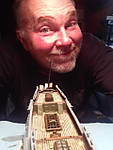I was referring to the casemate Rodger. All I can find is how she was built. This is from the CSS Virginia website...
"The wood was two feet thick; it consisted of oak plank 4 inches by 12 inches, laid up and down next the iron, and two courses of pine, one longitudinal of eight inches thickness, the other twelve inches thick.
The intervening space on top was closed by permanent gratings of two-inch square iron two and one-half inches apart, leaving opening for four hatches, one near each end, and one forward and one abaft the smoke-stack. The roof did not project beyond the hull. There was no knuckle as in the Atlantic,[E3] Tennessee and our other ironclads of later and improved construction. The ends of the shield were rounded.
The armor was four inches thick. It was fastened to its wooden backing by one and three-eighths inch bolts, countersunk and secured by iron nuts and washers. The plates were eight inches wide. Those first made were one inch thick, which was as thick as we could then punch cold iron. We succeeded soon in punching two inches, and the remaining plates, more than two-thirds, were two inches thick. They were rolled and punched at the Tredegar Works, Richmond. The outside course was up and down, the next longitudinal. Joints were broken where there were more than two courses.
The hull, extending two feet below the roof, was plated with one inch iron; it was intended that it should have had three inches."
Gator 











